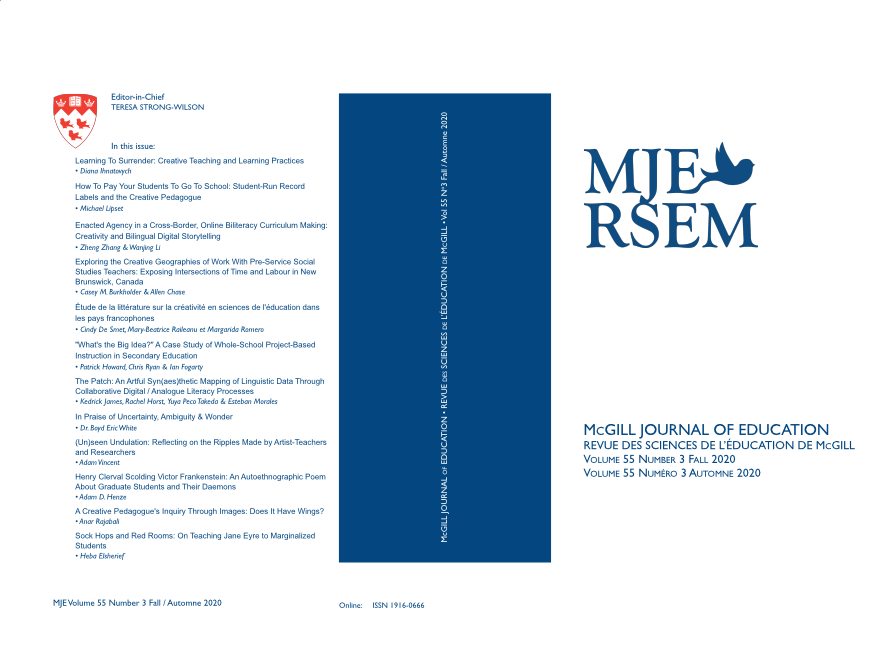The Patch: An Artful Syn(aes)thetic Mapping Of Linguistic Data Through Collaborative Digital / Analogue Literacy Processes
Keywords:
digital literacy, arts-based research, creative economies, sonification, text analysis visualization, discursive ecologyAbstract
The Patch workshop explores creative / critical analyses that can map the collectively relevant topoi of semiosis in linguistic texts according to the three ecologies as articulated by Félix Guattari. As creative pedagogues both in service and critical of creative economics, we valourize a generative practice, one that results in successive creative readings, writings, visualizations, sonifications and audiovisual artifacts. The Patch is a human-computer procedural algorithm, engaging a series of recursive and recombinant processes that utilize several software programs, collaborative writing and performance practices to bridge analogue and digital literacies. A total of 80 teacher education students, graduate students and faculty, working with a single input text, provided the data reported in this paper.
References
Adema, J., & Hall, G. (2016). Posthumanities: The dark side of 'The Dark Side of the Digital'. Journal of Electronic Publishing, 19(2), n.p. https://doi.org/10.3998/3336451.0019.201
Baldick, C. (2015). Close reading. In The Oxford Dictionary of Literary Terms (4th ed.). Oxford University Press.
Bateson, G. (1972). Steps to an ecology of mind. Ballantine Books.
Borges, J. L. (1975). On exactitude in science. In J. L. Borges (Ed.), A universal history of infamy (N. T. di Giovanni, Trans.) (p. 131). Penguin Books Ltd.
Carroll, L. (1893). Sylvie and Bruno concluded. Lit2Go. https://etc.usf.edu/lit2go/211/sylvie-and-bruno-concluded/4652/chapter-11-the-man-in-the-moon/
Del Maschio, G. (n.d.). iReadFast. Gengisweb. http://www.gengis.net/prodotti/iReadFast_Mac/en/index.php
Department for Culture, Media, and Sport [DCMS]. (1998). Creative industries mapping document. London: Department for Culture Media and Sport. https://www.gov.uk/government/publications/creative-industries-mapping-documents-1998
Department for Culture, Media, and Sport [DCMS]. (2016). The Culture White Paper. London: Department for Culture, Media & Sport. https://assets.publishing.service.gov.uk/government/uploads/system/uploads/attachment_data/file/510798/DCMS_The_Culture_White_Paper__3_.pdf
Deleuze, G., & Guattari, F. (1983). Anti-Oedipus: Capitalism and schizophrenia. University of Minnesota Press.
Deleuze, G., & Guattari, F. (1987). A thousand plateaus. University of Minnesota Press.
Gavin, M. (2019). Is there a text in my data? (Part 1): On counting words. Journal of Cultural Analytics, 1(1), 1–24. https://doi.org/10.22148/001c.11830
Gaztambide-Fernández, R. A. (2009). Toward creative solidarity in the “next” moment of curriculum work. In E. Malewski (Ed.), Curriculum studies handbook: The next moment (pp. 78-94). Routledge.
Guattari, F. (2000) The three ecologies. The Althlone Press.
Hayles, N. K. (1993). Virtual bodies and flickering signifiers. October, 66, 6991. https://doi.org/10.2307/778755
Hayles, N. K. (1999). How we became posthuman: Virtual bodies in cybernetics, literature, and informatics. The University of Chicago Press.
James, K. (2017a). Antics of a cultural recycler: Visualizing data poetry. In L. Butler-Kisber, J. J. Guiney Yallop, M. Stewart, & S. Wiebe (Eds.), Poetic inquiry: Reflections and renewal. (pp. 244-259). MacIntyre Purcell Publishing.
James, K. (2017b). The piano plays a poem. In P. Sameshima, A. Fidyk, K. James, & C. Leggo (Eds.), Poetic inquiry: Enchantment of place. (pp. 49-58). Vernon Press. https://doi.org/10.1080/00332925.2019.1568122
King, T. (2003). The truth about stories. House of Anansi Press.
Klobucar, A., & Ayre, D. (n.d.) GTR Language Workbench. https://web.njit.edu/~newrev/3.0/workbench/Workbench.html
Lessig, L. (2004). Free culture: How big media uses technology and the law to lock down culture and control creativity. Penguin. https://www.loc.gov/item/2019666613/
Moretti, F. (2000). Conjectures on world literature. New Left Review, (1), 54–67. https://newleftreview.org/issues/ii1/articles/franco-moretti-conjectures-on-world-literature
Online Random Tools (n.d.). Word Shuffler. Browserling. https://onlinerandomtools.com/shuffle-words
Palmer (née Reiser), M., & Jones, O. (2014). On breathing and geography: Explorations of data sonifications of timespace processes with illustrating examples from a tidally dynamic landscape. Environment and Planning A, 46(1), 222-240. https://doi.org/10.1068/a45264
Paranyushkin, D. (2011). Identifying the pathways for meaning circulation using text network analysis. Nodus Labs. https://noduslabs.com/research/pathways-meaning-circulation-text-network-analysis/
Paranyushkin, D. (2012). Visualization of texts polysingularity using network analysis. Nodus Labs. https://noduslabs.com/research/visualization-text-polysingularity-network-analysis/
Peña, E., & James, K. (2016). A glitch pedagogy: Exquisite error and the appeal of the accidental. Journal of the Canadian Association for Curriculum Studies, 14(1), 108-127. https://jcacs.journals.yorku.ca/index.php/jcacs/article/view/40306/36169
Peña, E., & James, K. (2020). Raw harmonies: Transmediation through raw data. Leonardo, 53(2), 183-188. https://doi.org/10.1162/leon_a_01635
Richardson, L. (2000). Writing: A method of inquiry. In N. K. Denzin & Y. S. Lincoln, (Eds.), Handbook of qualitative research (2nd ed.). Sage Publications.
Rosenblatt, L. M. (1994). The reader, the text, the poem: The transactional theory of the literary work (Paperback ed.). Southern Illinois University Press.
Schlesinger, P. (2016). The creative economy: Invention of a global orthodoxy. Innovation: The European Journal of Social Science Research, 30(1), 73-90. https://doi.org/10.1080/13511610.2016.1201651
Schulz, K. (2011). What is distant reading? The New York Times. https://www.nytimes.com/2011/06/26/books/review/the-mechanic-muse-what-is-distant-reading.html
Swiss, T., & Burgess, H. (2012). Collaborative new media poetry: Mixed and remixed. In A. A. Delwiche, J. J. Henderson, & Ebooks Corporation (Eds.), The participatory cultures handbook. Routledge. https://doi.org/doi:10.4324/9780203117927
Torres, R. (2005). Digital poetry and collaborative wreadings of literary texts. Telepoesis. http://www.telepoesis.net/papers/dpoetry.pdf
Wetzel, M. (2006). The authority of drawing: Hand, authenticity and authorship. In S. Neef, J. V. Dijck, & F. C. J. Ketelaar (Eds.), Sign here: Handwriting in the age of new media (1st ed.) (pp. 50–59). Amsterdam University Press. https://doi.org/10.25969/mediarep/13237
Wildfeuer, J. (2014). Film discourse interpretation: Towards a new paradigm for multimodal film analysis. Routledge.
Yúdice, G. (2003). The expediency of culture. Duke University Press.
Published
How to Cite
Issue
Section
License
Copyright (c) 2021 McGill Journal of Education / Revue des sciences de l'éducation de McGill

This work is licensed under a Creative Commons Attribution-NonCommercial-NoDerivatives 4.0 International License.
Those wishing to reproduce all or part of any material published on this website are asked to email mje.education@mcgill.ca for permission and to acknowledge the McGill Journal of Education as the original source.
Authors must transfer copyright of their article to MJE. Authors may use all or parts of their work in any future publication with the article's origin in MJE acknowledged in the customary manner.
A copy of our standard form may be requested from mje.education@mcgill.ca





